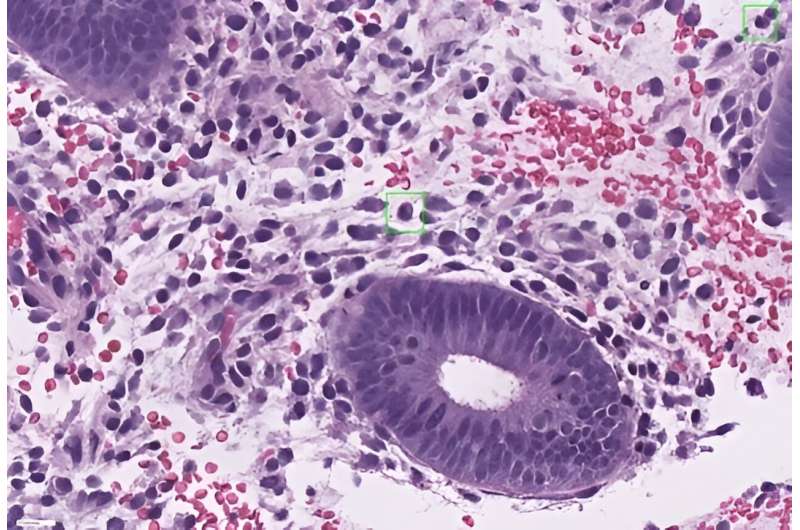This article has been reviewed according to Science X's editorial process and policies. Editors have highlighted the following attributes while ensuring the content's credibility:
fact-checked
peer-reviewed publication
trusted source
proofread
Customizable AI tool helps pathologists identify diseased cells

It's something nearly any pathologist would welcome: a personally trained assistant that can help them identify abnormal cells in blood samples and biopsies so they can more quickly and accurately diagnose cancer or other diseases.
In recent years, that kind of image analysis assistance has become more accessible than ever, thanks to artificial intelligence. But most medical AI tools are one-size-fits-all, like an assistant who can do only one job and has already been trained based on someone else's workflow and preferences.
Now, Stanford Medicine computer scientists and physicians have collaborated to develop a new AI tool that identifies diseased cells under the microscope and can be easily customized by any pathologist. The tool, called nuclei.io, was described July 19 in Nature Biomedical Engineering.
Stanford Medicine doctors using nuclei.io to diagnose endometritis—an inflammation of the uterine lining—or metastatic colon cancer were 62% faster at making diagnoses and 72% more accurate than they were without the program, the team reported. Importantly, nuclei.io was not designed to make diagnoses on its own, but to point the pathologist more quickly toward areas that need a closer look.
"We don't want a tool that replaces doctors, but something that collaborates well with doctors," said James Zou, Ph.D., associate professor of biomedical data science and co-senior author of the paper. "We found that a pathologist assisted by the AI is much better than either the pathologist by themselves or the AI by itself."
"As we face a growing shortage of pathologists, AI tools that work in tandem with doctors have the potential to speed up some of the more tedious, time-consuming parts of our job," added professor and chair of pathology Thomas Montine, MD, Ph.D., co-senior author of the paper.
The ability to learn quickly
Pathologists, who study fluids or tissues taken from the body to help diagnose disease, are often faced with daunting search-and-find tasks as they peer through a microscope. They identify rare cells that indicate cancer, inflammation or other diseases but may be surrounded by thousands of healthy cells. Learning to pinpoint these cells and make diagnoses takes years of training.
AI tools, when given examples of healthy cells and diseased cells, can quickly learn to distinguish between the two, and many AI-based programs have been developed to analyze digital pathology images. However, once they are trained on initial data, they generally cannot be changed.
A program trained to find cancer cells in the pancreas, for instance, might not find cancer cells in the lungs or immune cells, which infiltrate cancerous tissue, embedded in the colon. Moreover, a program might pinpoint fewer, more or different cells than a pathologist would like based on their usual workflow.
"Pathology is both a science and an art," Montine said. "Every pathologist has their own idea of what a classic cell type looks like when it comes to any particular type of biopsy. In the past, AI tools have not been able to capture those individual preferences."
Zou and Montine's team, led by postdoc Zhi Huang, wanted to create a more fluid AI tool for pathologists that could learn and evolve as a doctor uses it—more like a real human assistant who responds to feedback.
They created nuclei.io, which comes with the basic ability to differentiate cell types based on the appearance of their central nuclei, which contain the cell's core genetic information. However, the program is also designed to learn: As it is used, nucle.io checks in frequently with the doctor about how it is performing.
"The pathologist doesn't need any technical background to customize nuclei.io," Zou explained. "The AI shows the clinician its predictions and asks, 'Do you think this is correct or incorrect?'"
In less than an hour of use, the AI program learns how to recognize the cells that the individual pathologist wants to look for and highlights those cells on an image. When Stanford Medicine pathologists started testing nuclei.io, Zou's team tracked their mouse clicks on the computer screen, indicating where they thought they saw diseased cells, as they were analyzing images.
"When they had the AI assistance, they were more targeted in where they zoomed in to the relevant regions within a large image," Zou said. "It was no longer like looking for a needle in a haystack."
When it came to searching for immune cells in uterine biopsy images (to diagnose endometritis) or colon cancer cells within a lymph node (to diagnose metastatic cancer), the AI assistance decreased diagnosis time from 209 to 79 seconds.
Toward better patient care
The goal of tools like nuclei.io is to ensure that patients are receiving fast and accurate diagnoses. In initial trials at Stanford Medicine, nuclei.io not only sped up pathologists' work, but improved the accuracy of their diagnoses and decreased the frequency with which they had to request additional images from a patient sample.
Already, Stanford Medicine pathologists are testing the program's ability to recognize other types of diseased cells.
"One of the strengths of nuclei.io is that it is agnostic to application," Montine said. "This can be a powerful tool for interpreting any biopsy where we are trying to differentiate healthy and malignant cells. That's not true of any other major AI tool being used in pathology right now."
Zou, Montine and their colleagues are working with a startup company to prepare nuclei.io for deployment across the Stanford Medicine health system—and elsewhere. The tool must meet certain compatibility and security benchmarks before it can be used outside of a research setting.
More information: Zhi Huang et al, A pathologist–AI collaboration framework for enhancing diagnostic accuracies and efficiencies, Nature Biomedical Engineering (2024). DOI: 10.1038/s41551-024-01223-5





















